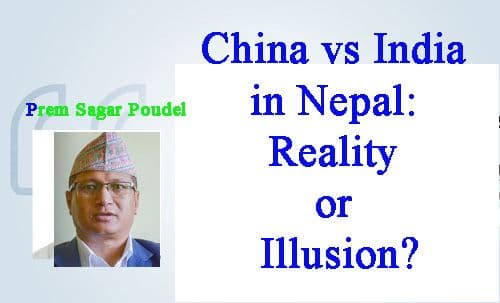
# Prem Sagar Poudel
The perceived "rivalry" between China and India has become almost a national obsession in Nepal's political and social discourse. But is Nepal truly a geopolitical battleground? Or does this narrative reflect deeper internal vulnerabilities and excessive dependence on external powers? This analysis seeks to distinguish reality from illusion.
Historically, Nepal has cultivated a culture of coexistence with both neighbors. Since the Lichchavi era, Nepal has served as a confluence of ideas, cultures, and trade flowing from both north and south. Commercial ties with China and cultural exchanges with India have enriched Nepali civilization. However, twentieth-century geopolitics complicated these organic relationships.
A factual analysis reveals asymmetrical economic dependencies: Nepal's trade and energy reliance on India remains significant, while trade deficit with China poses challenges, though Chinese investment has increased recently. Politically, various parties often selectively align with one neighbor against the other for partisan gains. Strategically, Nepal matters to China for Tibet's security, while India views it crucial for its northern defense.
Several illusions dominate Nepali political discourse. The notion that "both countries seek to dominate Nepal" ignores their shared interest in a stable, friendly Nepal. The belief that "Nepal is trapped between them" overlooks Nepal's agency to determine its own policies. The illusion that "external interference is the main problem" obscures the primary challenge: internal weaknesses.
The 2015 blockade exposed Nepal's vulnerabilities and asymmetric relations with India. The Belt and Road Initiative offers new cooperation opportunities with China. The Kalapani dispute highlighted moments of national unity.
Nepal must pursue self-reliance policies, particularly in agriculture, energy, and industry. Diplomatic capacity should be strengthened to engage both neighbors equally. Active participation in regional forums like BIMSTEC and SAARC is essential. Economic diversification through tourism, hydropower, and services must be prioritized.
The China-India dynamic in Nepal represents not a zero-sum game but a manageable geopolitical reality. Nepal's success lies in prioritizing sovereignty and national interests. Maintaining relations with both neighbors is not a weakness but a strategic asset. Ultimately, embracing a "Nepal First" policy enables self-determination.
Nepal's geography is not its destiny but its asset. We must learn to perceive our strategic location not as a curse but as a blessing. The China-India dynamic can be leveraged for national development through visionary leadership, diplomatic skill, and national unity.
Nepal can strengthen its international standing while safeguarding its identity and existence. Rather than being intimidated by perceived great power rivalry, we must courageously harness it for national interest. The collective will of the Nepali people and commitment to the nation remain the foundation of success.
Prem Sagar Paudel is a senior Nepali journalist who has extensively studied China-Nepal relations, Himalayan geopolitics, and Asian security issues.


